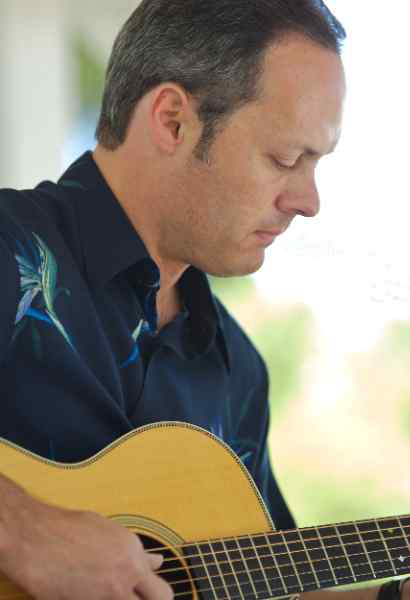A real live ‘shoot’
Marty Paris is not only a friend, he is also a fine acoustic guitarist. So when Marty asked me to take pictures at his open air concert this weekend I was glad to oblige, though somewhat apprehensive about the high contrast lighting issues this opportunity would present.
I would like to tell you that I took ‘just the EOS 5D and a couple of lenses’ for the ‘shoot’ (ugh!) but then I only have a couple of lenses, so that’s what I took!
The group, comprised of two guitarists, a vocalist and a drummer, would be playing at the town square in Templeton, near my home, in the shade of the bandstand. A charming throwback to all that was good and great in Norman Rockwell’s America. People gambolling about with children and dogs. A hot dog stand. Sunshine and oak trees. Church steeples at every corner with the fire engine poised in case of emergency.
All well and good, but the bright sunlight meant blown out backgrounds from the huge contrast between lighting on the performers and the park setting. So I decided to make virtue out of necessity and used the Canon 200mm f/2.8 ‘L’ lens (what a piece of glass!) mostly at f/2.8 to blur the background and give the pictures that studio look. Hardly the controlled environment of a studio, but the best I could do. The 5D was set at 400 ISO which resulted in short shutter speeds, mitigating the absence of the wonderful IS feature in the 200mm lens. Canon, are you listening? And prior experience with the 5D had confirmed that ISO 400 is grain free at any realistic enlargement size. Try that with color film!

I used that inspired little belt-mounted back up gadget, the exotically named Hyperdrive, to dowload full CF cards from the camera, alternating the one in the Hyperdrive with the one in the 5D. I ended up taking some 350 RAW pictures or some 6 cards’ full, and if you think that’s a lot, words fail me when trying to explain how many reasons there are for a bad picture in this environment. Clutter everywhere, closed eyes when they should be open, background noise, and on and on.
It took some 25 minutes to load Aperture from the Hyperdrive when getting home and, owing to Aperture’s superb user interface, only another three hours to cull the pictures down to the 85 best. That includes deletion of bad pictures, exposure correction and the occasional crop or straightening of the horizon. The only snags I ran into were that Aperture locked up on me twice when downloading from the Hyperdrive (no images were lost) and would take up to 20 seconds to load an image for processing. My iMac G5 has the modest Nvidia Radeon 6600 graphics card which is the major cause of the slow loading of an image on the screen. Then again, the iMac costs $1,500 rather than the $5,000 it would take to get a full blown Mac with a posh video card and Cinema Display. I can wait a few seconds for a picture to load at that price difference.
85 is a lot of photographs to end up with but the goal was to give each performer twenty or so pictures to choose from. You can see the snaps here.
Some practical notes from this little assignment. I set the focus sensor in the 5D to the center rectangle. I was not about to trust the camera’s system to guess optimum focus at f/2.8 with the 200mm lens when depth of field can be as little as an inch or so. I would generally take an exposure reading (using center weighting) from the concrete floor of the bandstand and lock it before composing, then locking focus with a first pressure of the shutter release on the performer’s eyes prior to final composition. This is all very fast once you get the hang of it. Despite all this I got the exposure wrong in several pictures, but RAW is so forgiving that correction in Aperture was easy without any noticeable quality loss. In particular I find the Highlights & Shadows slider in Aperture far superior to that in Photoshop as it produces far more realistic results and introduces far less noise into the image.
The slide show was generated using Aperture’s web creation function and this took far too long compared to using iPhoto. Some three hours. Apple really needs to speed this up.
The next morning I made four 13″ x 19″ prints on the HP DesignJet 90 plus five CDs with the slide show, and they were at Marty’s door by noon. I was trying to emulate what, say, a wedding pro might be faced with in delivering timely results to his client. The workflow above was encouraging in two respects. The percentage of overall time spent on processing compared to photography was relatively low and the processing experience was markedly stress free. So the 5D + RAW + Aperture + HP DesignJet proved to be a powerful and effective set of tools.
Was my ‘client’ pleased? Well, there were a lot of gurgling noises on the phone when he called back, so you be the judge. Now maybe I can get him into my studio.